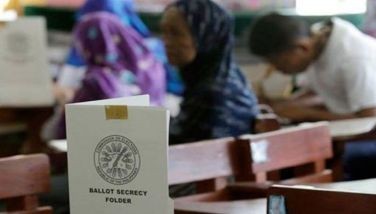Sandigan stops sheriff from implementing seize order on Erap assets
The Sandiganbayan ordered yesterday a freeze on government’s seizure of the personal properties of former President Joseph Estrada.
The anti-graft court’s First Division issued the ruling after hearing the defense’s oral arguments on a motion to quash the writ of execution for the forfeiture of Estrada’s assets and properties.
In its order, the Sandiganbayan asked court Sheriff Edgardo Urieta to stop the confiscation pending the resolution of the defense’s motion.
The forfeiture of Estrada’s assets was included in the Sandiganbayan ruling on Sept. 12 convicting the ousted president of plunder.
The assets for forfeiture include more than P700 million in cash deposited in the accounts of Erap Muslim Youth Foundation and Jose Velarde, the so-called Boracay mansion in
President Arroyo pardoned Estrada days after his conviction but required him to follow the court’s ruling on the forfeiture of assets that were deemed illegally acquired.
The Special Division was composed of Associate Justice Francisco Villaruz as acting head and Associate Justices Diosdado Peralta and Rodolfo Ponferrada.
During the oral arguments, Special Prosecutor Dennis Villa-Ignacio insisted that based on the Plunder Law, the government may seize Estrada’s other assets if the former president fails to satisfy the court’s penalties.
But defense counsel led by Estelito Mendoza said that based on Articles 25, 38 and 45 of the Revised Penal Code, only specific assets and properties mentioned in the court’s decision to forfeit could be seized.
Villa-Ignacio countered that Estrada could be liable for violation of the Revised Penal Code for violating the condition for his pardon.
He said the presidential pardon may be revoked and Estrada sent back to prison.
Villa-Ignacio said Estrada’s lawyers were merely delaying the execution of the writ.
“They would like this to last for another seven years. It could be their plan to delay again the final disposition of this case for another three to seven years,” Villa-Ignacio said.
He said that at the start of the Estrada trial, the prosecution was granted a general writ of attachment against all properties of the former president. “Most probably, since it has not been recalled, set aside, revised, or modified, then the court or the sheriff can still avail of the general writ of attachment issued to satisfy the judgment rendered. Estrada is a judgment debtor,” said Villa-Ignacio.
He also rebuffed the defense’s claim that only P2,000 was left for forfeiture. “That’s not supposed to be the process,” he lamented.
Villa-Ignacio explained that if there is a conflict between a general statute, which is the Revised Penal Code, and a special statute or specific statute, which is the Plunder Law, the special or specific statute should prevail over the general statute.
“The arguments are inappropriate, irrelevant and immaterial. There have been decisions about this argument,” he said.
Villa-Ignacio also said that the prosecution was able to show during the trial that in a year’s time, Estrada was able to accumulate over P3.2 billion in the Jose Velarde account.
“Since the court says he is the owner (of the account), the presumption is he was the one who withdrew the money (P3.2 billion),” he said.
For his part,
“As I have stated, the prosecutors did not rebut the point that the court’s decision ordered a specific property forfeited. And I emphasize the word ‘specific,’ nothing else is ordered forfeited than what is mentioned in the decision of the court,”
“That is why you cannot find the court mention in the decision the Tanay property and the motor vehicles. What is ordered forfeited is what is stated only explicitly in the court’s decision. That is a basic and fundamental rule,”
Estrada said he was glad to get a reprieve from the Sandiganbayan.
“All those properties that I acquired before I became president legally belong to me. They have no business getting them,” Estrada told The STAR in a telephone interview.
Estrada said the best documentary pieces of evidence that he could present to the government were the titles to his real estate assets, which indicated the dates the properties were acquired.
- Latest
- Trending































